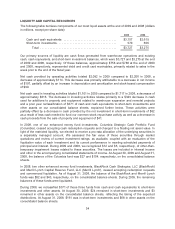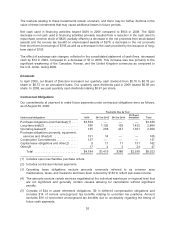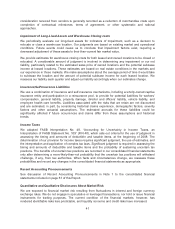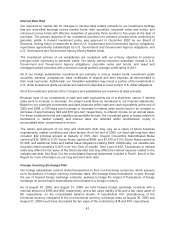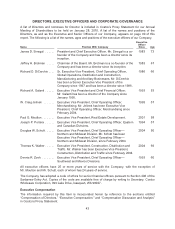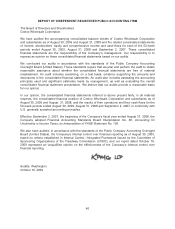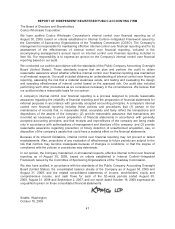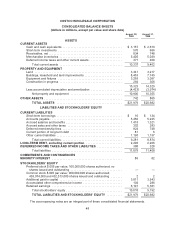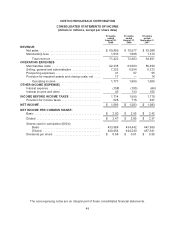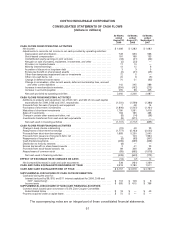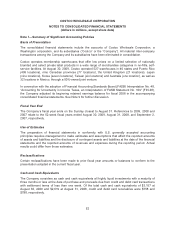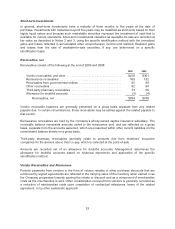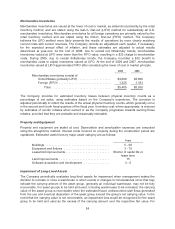Costco 2009 Annual Report Download - page 46
Download and view the complete annual report
Please find page 46 of the 2009 Costco annual report below. You can navigate through the pages in the report by either clicking on the pages listed below, or by using the keyword search tool below to find specific information within the annual report.MANAGEMENT’S REPORTS
Management’s Report on the Consolidated Financial Statements
Our management is responsible for the preparation, integrity and objectivity of the accompanying
consolidated financial statements and the related financial information. The financial statements have
been prepared in conformity with U.S. generally accepted accounting principles and necessarily
include certain amounts that are based on estimates and informed judgments. Our management also
prepared the related financial information included in this Annual Report on Form 10-K and is
responsible for its accuracy and consistency with the financial statements.
The consolidated financial statements have been audited by KPMG LLP, an independent registered
public accounting firm, who conducted their audit in accordance with the standards of the Public
Company Accounting Oversight Board (United States). The independent registered public accounting
firm’s responsibility is to express an opinion as to the fairness with which such financial statements
present our financial position, results of operations and cash flows in accordance with U.S. generally
accepted accounting principles.
Disclosure Controls and Procedures
As of the end of the period covered by this Annual Report on Form 10-K we performed an evaluation
under the supervision and with the participation of management, including our Chief Executive Officer
and Chief Financial Officer, of our disclosure controls and procedures (as defined in Rules 13a-15(e) or
15d-15(e) under the Securities and Exchange Act of 1934 (the Exchange Act)). Based upon that
evaluation, our Chief Executive Officer and Chief Financial Officer concluded that, as of the end of the
period covered by this Annual Report, our disclosure controls and procedures are effective.
There has been no change in our internal control over financial reporting (as defined in Rules 13a-15(f)
or 15d-15(f) of the Exchange Act) during our most recently completed year that has materially affected,
or is reasonably likely to materially affect, our internal control over financial reporting.
The certifications of our Chief Executive Officer and Chief Financial Officer required by Section 302 of
the Sarbanes-Oxley Act of 2002 are filed as Exhibit 31.1 in our Form 10-K.
Management’s Annual Report on Internal Control over Financial Reporting
Our management is responsible for establishing and maintaining adequate internal control over
financial reporting as defined in Rule 13a-15(f) under the Exchange Act. Our internal control over
financial reporting is designed to provide reasonable assurance regarding the reliability of financial
reporting and the preparation of financial statements for external purposes in accordance with U.S.
generally accepted accounting principles and includes those policies and procedures that: (1) pertain
to the maintenance of records that in reasonable detail accurately and fairly reflect our transactions
and the dispositions of our assets; (2) provide reasonable assurance that our transactions are recorded
as necessary to permit preparation of financial statements in accordance with generally accepted
accounting principles, and that our receipts and expenditures are being made only in accordance with
appropriate authorizations; and (3) provide reasonable assurance regarding prevention or timely
detection of unauthorized acquisition, use or disposition of our assets that could have a material effect
on our financial statements.
Because of its inherent limitations, internal control over financial reporting may not prevent or detect
misstatements. Therefore, even those systems determined to be effective can provide only reasonable
assurance with respect to financial statement preparation and presentation.
44


